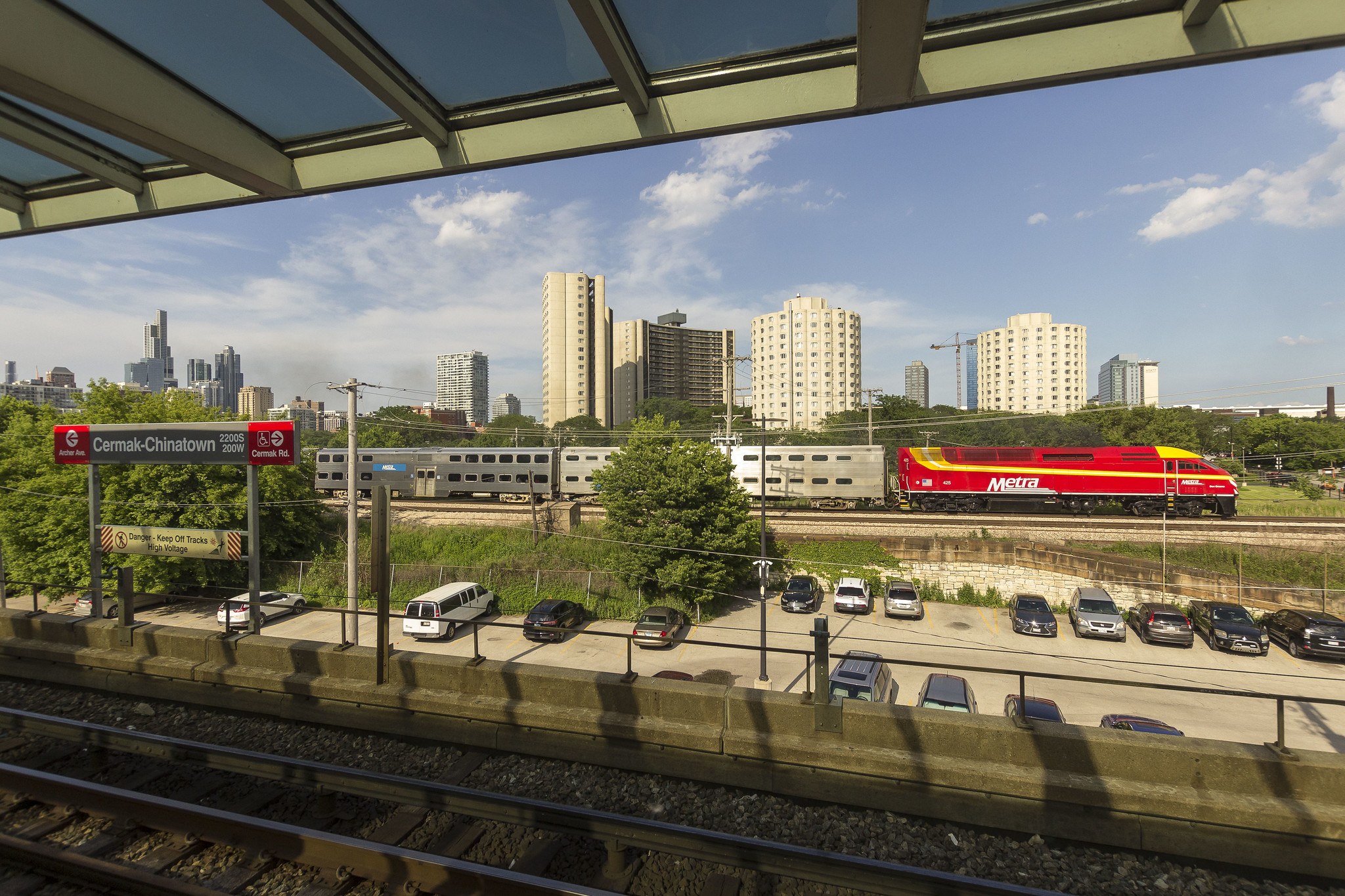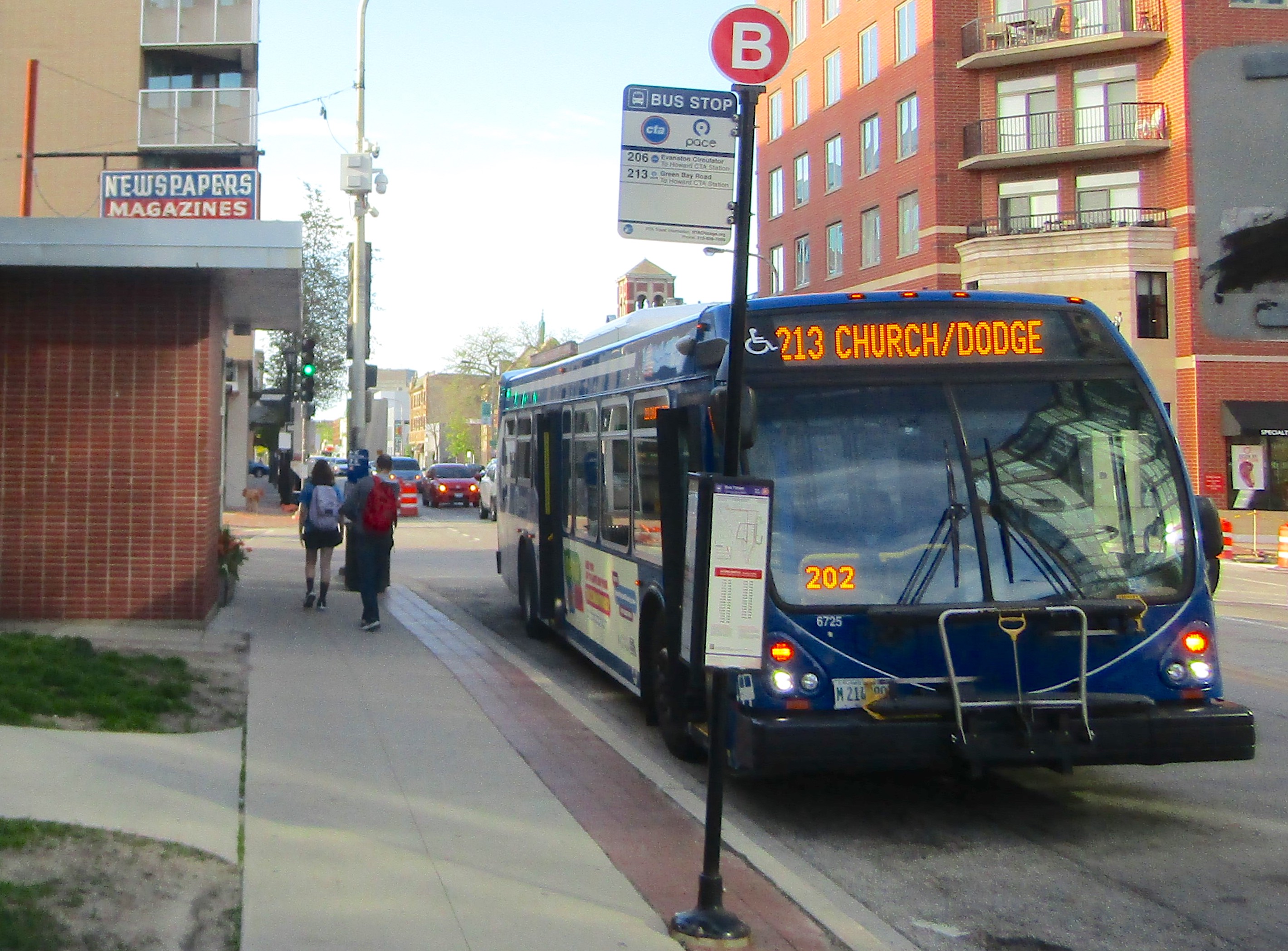Uncharted territory: RTA leaders discuss how Chicago transit will survive COVID-19
6:14 PM CDT on May 21, 2020

A Metra train viewed from the Cermak-Chinatown Red Line platform. Photo: Jonathan Lee
It goes without saying that the Chicago region's transportation agencies are facing massive headwinds amidst the pandemic, when ridership and revenue is plummeting. The Regional Transportation Authority, which oversees the CTA, Metra, and Pace, is trying to make wise decisions during this extremely challenging period, but it hasn't ruled out more service cuts further down the line.
On Monday, the Chicago Central Area Committee, an urban planning organization, hosted a webinar focusing on how the RTA, the CTA, Metra and Pace are dealing with COVID-19, featuring RTA chair Kirk Dillard and RTA executive director Leanne Redden. They argued that transit agencies will need to get creative as the economy reopens, since they'll need to transport more riders to work while keeping buses and trains uncrowded enough for social distancing. And while stimulus money has helped the agencies stay afloat, that funding only goes too far. Moreover, with local transit funding heavily dependent on fares and sales taxes, they expect the fallout from COVID-19 to affect transit for years to come.
Dillard reported that, collectively, the three transit systems saw their ridership plunge by 79 percent. Metra, which is heavily used by downtown office employees, has fared the worst, losing a staggering 97 percent of its ridership. The CTA has seen overall ridership drop by 80 percent although bus service on the South and West side, which is more likely to be used by essential workers, has seen less of a ridership reduction. Pace's ridership has fallen by 71 percent.
Dillard noted that while Metra has been cutting its service drastically and Pace has suspended and decreased service on many routes (mostly commuter shuttles), the CTA has kept service at a similar levels as before the crisis in order to encourage social distancing. Keeping Night Owl service running, the chair noted, is particularly important to ensure healthcare workers can get to their shifts.
When it comes to funding, RTA agencies have been hit with a “triple whammy,” Dillard said. “Operations are funded about 40 percent from fare revenue, 40 percent from RTA sales tax collection, and 20 percent from public funds. Obviously, sales tax is way down, and ridership, as I said earlier, is just decimated.”
Another issue if funding for capital projects. Funding for the $45 billion Rebuild Illinois infrastructure bill passed last year relies, in large part, on an increase in the gasoline tax, and with fewer people driving to work at the moment, that revenue is expected to shrink.
For the time being, Dillard said, the transit agencies are moving ahead on about half of their capital projects, prioritizing new rolling stock and, in Metra's case, locomotives. “Nobody knows when [the pandemic] is going to end, but because of the steps we have taken, we're in better position than if this pandemic hit several years ago,” he added.
Redden said that, while the ridership drop has been drastic, transit use had already been declining over the past few years, a phenomenon something she attributed to more people working from home and the widespread use of ride-share and parking apps. And while she said it's impossible to predict what will happen once the Restore Illinois plan starts to gradually reopen the state, she expects the economic aftershocks to reverberate for a long time.
“No one can ever be prepared for a global pandemic, but this is very different from a recession we can bounce back from,” Redden said. “Like the rest of the economy, I think this will not be a easy recovery [for transit].” As such, she said, “funding and operation changes will likely be needed.”

In the near term, the Coronavirus Aid, Relief, and Economic Security (CARES) Act provided $1.48 billion to make up for revenue losses and keep the transit services running. Redden said that the funding applied not just to Chicagoland, but the neighboring portions of Northwest Indiana and Southeast Wisconsin. The Federal Transit Administration documents mention that $51,422,091 of that money went to Indiana, but makes no mention of funding for Wisconsin.
Redden said that around $817 million of the money went to the CTA, roughly $475 million went to Metra, and about $412 million went to Pace. She added that, at this point, RTA is operating under the assumption that it won't get any more federal aid. “I'm not one to count my chickens before they hatch,” she said. “We can't count on additional dollars coming our way at this point.”
Asked how the transit agencies will ensure riders can maintain social distance as the economy opens up, Dillard said that they will have to be innovative. “I'm sure we'll be working with employer groups on the timing of when different businesses go to work, so we can space out the busy times,” he said.
When asked how Metra is doing on meeting the Positive Train Control requirements, whose deadlines haven't changed during the pandemic, Dillard said that while it's a “very expensive process, an unfunded federal mandate,” he doesn't expect the commuter rail provider to have any problems. “Metra is fine,” he said. “It's going to meet its deadlines, and it's going to be a leader, nationally.”
Metra is currently doing final PTC testing on the Metra Electric line. As part of that work, they going ahead with a slightly slimmed down version of the revised regular schedule, just to make sure PTC works the way it's supposed to. Once that testing is wrapped up, Metra will move on to the two Milwaukee District lines, with the goal of implementing PTC by the end of the year.
The officials were also asked how the pandemic affects the state requirement that transit agencies get at least half of their revenue through fares. Redden responded that CARES funds are covering the funding gap at the moment, but the RTA is having discussions with state legislators to address future shortfalls. “In the long term, I think these are some of the bigger policy questions we need to talk about,” she said.
When asked about possible service cuts, Redden said at this point, “there's no plan to cut any service and operations.” In fact, the agencies are hoping to gradually increase service as the economy opens up. But she did not rule out service cuts in 2021.
“It's sort of this paradox: As we try to accommodate social distancing, we need to provide a lot of service [while taking in less money],” Redden said. “These are the issues that we will talk about [while crafting next year's budgets].”
At the moment, CTA and Pace buses are officially free, while Metra trains are de-facto free. While riders have been encouraged to buy tickets through the Ventra app, conductors aren't going through train cars to check tickets in order to reduce the risk of infection, so payment is strictly on the honor system. The only place you currently have to pay a fare right now is on the CTA 'L'.
Asked what the transit agencies' plans are for making customers pay fares as the state reopens, Redden responded, Redden noted that the CTA is in the process of installing fare card readers at the rear bus doors, and Metra is looking into additional cashless payment options. The commuter transit agency was discussing ways to reduce fare evasion earlier this year, including potentially adding ticket vending machines at outlying stations and installing turnstile gates at Union Station, before COVID-19 sidelined those plans.
“Metra is one of those agencies that's reviewing some of the capital programming investment where Metra can catch up on those purchases and accelerating purchases [they already planned],” Redden said.
Read More:
Stay in touch
Sign up for our free newsletter
More from Streetsblog Chicago
Elevated Chicago’s new leader on how to build more support for equitable transit-oriented development
Recently announced as executive director Juan Sebastian Arias also shared his POV on Mayor Johnson's Cut the Tape initiative to speed up the development approval process
Since COVID, Pace ridership has fared better on major corridors and in north, northwest suburbs than in south, west ‘burbs
The suburban bus system's top five busiest routes largely maintained their ridership rankings.
Due to incredible support from readers like you, we’ve surpassed our 2023-24 fundraising goal
Once again, the generosity of walk/bike/transit boosters is fueling our reporting and advocacy.




